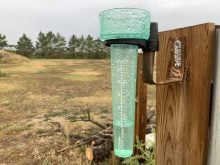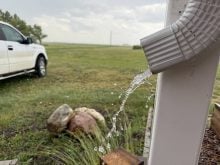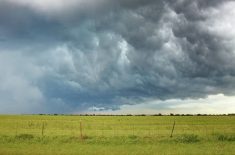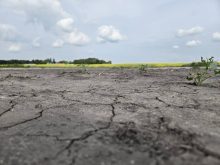Crop producers will have to wait until after harvest to find out if there is any government drought assistance, says the president of the Grain Growers of Canada.
The question of additional farm aid was put to Oneil Carlier, the new NDP agriculture minister, when he attended an Alberta Wheat Commission directors’ meeting in Red Deer on July 21, said Gary Stanford, who is also a director with that organization.
“I asked him if there will be any form of funding for cattle and hay, and also for some areas that are so dry that crop insurance for grain farmers won’t really cover everything,” said the Magrath-area producer.
“He said that he will probably wait until after harvest is over and he gets the crop insurance information back from the Agricultural Financial Services Corporation to see what the facts are. He’ll then find out which counties are in the worst shape.”
That same stance was taken by Federal Agriculture Minister Gerry Ritz at a national meeting of agriculture ministers held in mid-July. Ritz said he wants to see crop insurance reports before deciding if federal aid is required. However, he has authorized tax deferrals for some regions in Alberta, Saskatchewan, and B.C. (see ‘Tax relief‘ below).
Read Also

Grazing ‘sweet spot’ boosts pasture performance
Timing-focused approach to pasture management touted to boost forage growth, livestock gains while also cutting farmer labour and inputs
Since AgriStability, one of the federal government’s safety programs to help with income losses, has changed in the past few years, it’s not known if coverage will be adequate. The premiums have stayed the same, but coverage is much lower.
- More on the Alberta Farmer: Disaster declarations raise awareness
- More on the Alberta Farmer: ALERT Line: Help for farmers is only a phone call away
“For AgriStability, it’s almost like you have to have low grain prices and lower-yielding crops to get it to trigger,” said Stanford.
When grain prices were high, many producers opted out of AgriStability.
“Grain prices are going up a little bit because of the drought, so right now, we’re just going to wait and see how bad it will be in a few counties,” he said.
However, while a high percentage of producers take crop insurance, only about 30 to 40 per cent of producers take pasture insurance, said Stanford.
Recent rains have helped in some areas but for many, they’ve arrived too late.
“There will still be a lot of very bad crops in Alberta because there was no rain in May or June,” said Stanford.
Tax relief
In regions where tax deferrals for 2015 have been authorized, producers will be able to defer a portion of the proceeds from the 2015 sale of breeding livestock to help them replenish their stock in 2016.
Proceeds from these deferred sales will then be included as part of the producer’s income for the 2016 tax year, when the income can be partially offset by the cost of replacing breeding stock.
In order to be eligible to defer income, a breeding herd must have been reduced by 15 per cent, to allow for a 30 per cent deferral of income from net sales. If a herd declines by 30 per cent or more, 90 per cent of income from net sales can be deferred.
Eligible producers can request the deferral on their 2015 income tax returns. Producers facing cash flow challenge, especially if they need funds to purchase feed, can apply to the federal government’s Advance Payments Program to access low-interest loans.
Click here to visit the Agriculture and Agri-Food Canada website and a list of counties eligible for tax deferral. The list currently covers dozens of counties and municipal districts and could be expanded after consultation with the province.

















